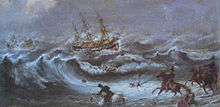Waterloo (ship)
 Image by the lithographer, Charles Hutchins, after a sketch by Lieut Hext of The King's Own Regiment | |
| History | |
|---|---|
| England | |
| Name: | Waterloo |
| Builder: | Bristol |
| Launched: | 1815 |
| Fate: | Wrecked in Table Bay on 28 August 1842 |
| General characteristics | |
| Class and type: | convict ship |
| Tons burthen: | 414 |
| Complement: | 300 crew and passengers |
The wreck of the Waterloo, a British convict ship, occurred on 28 August 1842, when a north-westerly gale struck Table Bay and drove ashore the Waterloo, the troopship Abercrombie Robinson and several other vessels lying at anchor nearby.
Wrecking
The 414-ton Waterloo was built at Bristol in 1815. She was an old ship with unsound timbers when she sailed from Sheerness on 1 June 1842 for Tasmania with three hundred crew and passengers.
The ship's surgeon, Dr Henry Kelsall, had persuaded Captain Henry Ager to put in at the Cape for fresh provisions, as many of those on board were suffering from scurvy. Consequently, the Waterloo entered Table Bay on 24 August 1842 and anchored in a position which was to prove unsafe for that time of year. The Captain went ashore and left the ship in charge of the Chief Mate Jackson.

On 26 August, a strong northerly gale sprang up, accompanied by heavy rain. The top-gallant masts snapped and landed on the deck. On 27 August, the surgeon became extremely concerned, especially when the two anchors gave way at about 11pm. He and the Second Mate lit flares to signal their desperate situation. Early on the morning of the 28th, the wind grew to hurricane strength, and the troopship Abercrombie Robinson was driven ashore. Fearing punishment, the First Mate refused to order the cutting away of the fallen masts. Dr Kelsall ordered the freeing of the prisoners from their irons. From this point on the situation rapidly deteriorated.
The Waterloo, helpless before the strong wind and high seas, was driven ashore; the masts broke and the ship heeled over on her side. Convicts leapt overboard, one of them aiding Dr Kelsall. Within two hours the ship had been reduced to fragments. In 1842, there were no lifeboats or rescue systems in place in Table Bay. Consequently, one hundred and eighty nine people died in the space of about two hours.
There were 113 survivors - 16 men of the guard, a soldier's wife, Mrs. Mulvaney, and 76 convicts. Lieutenant Hext, who commanded the guard, was on shore at the time and made a sketch of the wrecking. Captain Ager, Master of the Waterloo, survived, as did Mr. Jackson, Chief Mate; Mr. Gunner, 2nd mate; Mr. Gill, 3rd mate; and fifteen of the crew. One hundred and eighty nine people drowned, these being 143 convicts, 15 men of the 99th Regiment, together with 17 wives and children, the boatswain Mr. Chiverton, the sailmaker, the carpenter and 11 of the crew.[1][2]
Inquiry
There was no coroner's court, so that the resultant inquiry was informal and superficial. Captain Ager was censured for remaining ashore, while the first mate was criticised for not clearing the fallen masts and rigging. The inquiry also noted that the ship's timbers were rotten and in an unseaworthy condition. An editorial in the South African Commercial Advertiser of 31 August 1842 criticised the British authorities and the Waterloo's captain, stating that the weather, the water and the bottom were not the reason for the tragedy. It went on to say:
"The Abercrombie Robinson came into the bay on the evening of the 25th, when it was dark, proceeded too far up the Bay, and came to anchor in a position unsafe for her should it come on to blow. The wind did blow a gale with squalls, and she wisely went on shore with an anchor at her bows, thereby saving some seven hundred souls, most of whom must have perished had she foundered where she rode at anchor. Had she been in a proper position she would have rode out the weather like the other vessels. Of the Waterloo it is impossible to speak with moderation. Deadly blame rests somewhere, and justice will, we have no doubt, find out the parties that deserve it."
Similar wrecks
The 751-ton Dutch East Indiaman, Waddinxveen, and the Oosterland, had on 24 May 1697 been anchored in the same place near the mouth of the Salt River and been wrecked by a strong gale blowing from the same north-west direction. There were only 6 survivors from the Waddinxveen.[3][4]
References
- ↑ "Wreck of the Convict Ship Waterloo 1842". British Genealogy Forum. 5 January 2009.
- ↑ "Wreck of the Waterloo convict ship, Cape of Good Hope, 28th. August 1842". LINC Tasmania. Retrieved 21 April 2013.
- ↑ "Database – W". Shipwrecks of South Africa. Retrieved 21 April 2013.
- ↑ "An expencive day for the VOC". TreasureNet Forum. 24 February 2006.